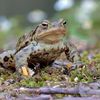Floating Nymph --- Nymphaea L.
Hier das Foto einer Seerose (Gattung Nymphaea, welche Sorte genau weiß ich jetzt nicht), dass ich in der Seerosenaustellung im Dortmunder Westfalenpark gemacht habe. Seerosen sind s.g. sekundäre Hydrophyten, das bedeutet, dass ihre Vorfahren noch am Land gelebt haben und sie erste später Wasserpflanzen wurden. So ein Leben im Wasser ist für eine Landpflanze allerdings schwer und braucht vielerlei Anpassungen. Eine der wichtigsten ist die Umstellung des Gefäßsystems. Pflanzen haben kein Herz, dennoch sind Landpflanzen in der Lage Nährstoffe nach oben zu pumpen indem sie in ihren Blättern Wasser verdunsten lassen und der Unterdruck zu einem "Fluss nach oben" führt. Wie bei einem Strohhalm. Bei Wasserpflanzen geht das natürlich nicht, aber die nehmen meist Nährstoffe direkt aus dem Wasser auf und brauchen daher keine Gefäße. Die Seerosen sind vermutlich ein Zwischending und versorgen sich teils aus dem Boden und teils aus dem Wasser. Ein faszinierender Einblick, wie die Evolution Wege findet, um neue Lebensräume zu erobern.
----------------------------------------------------
Here the picture of a water lilie (genus Nymphaea, I have no idea about the species), which I made in water lilie collection based in the Westfalenpark, the biggest park of Dortmund, Germany. Water lilies are so called secondary hydrophiles. This means their ancestors are land-based plants and they slowly adapted to a water-based life. Such a life inside a lake requires several adaptions and one of the most important ones is the changeover of the vascular system. Plants have no heart, obviously. Yet, they are able to transport nutrients from the ground to the leaves. They accomplish this by letting water evaporate in their leaves. The resulting vacuum inside their veins pulls water up the chunk like a straw. This is not possible for hydrophytes, but also not necessary since they absorb nutrients direct from the surrounding water. Water lilies are probably somewhere in-between those two and use both systems to supply themselves with nutrients. A fascinating example how the evolution works to conquer new habitats.






















mbuerstm 31/05/2022 16:39
Die leuchtet aber!Roman Dullek 11/10/2020 18:02
Hervorragende Nahaufnahme.Das Motiv ist perfekt freigestellt.
Danke für die Info. LG Roman
Gabi Jaeger 07/10/2020 19:38
Sie scheint richtig zu leuchten vor dem dunklen Hintergrund.Sieht sehr gut aus.
Das war bestimmt ein tolles Erlebnis im Wetsfalenpark.
Danke, wie immer, für deine interessanten Erklärungen zum
Foto-Thema.:-)
Liebe Grüße
Gabi
JAM-Fotografie 07/10/2020 14:11
Vor dem dunklen HG kommt die Blüte sehr schön zur Wirkung. Auch die Info zum Bild habe ich mit Interesse gelesen.Grüße Jürgen
Annegret H. 14/09/2020 10:04
Ein gelungenes Foto - feines Licht, gute Perspektive - dieser makellosen Blüte.LG Annegret
Stefan-67 12/09/2020 18:54
Meine Lieblingsblumen, auch weil man sie nicht aus Strauss schenken kann.Sehr schönes Foto.
LG Stefan
ALLWO 12/09/2020 18:06
Gut gewählte Seitenansicht auf die Blume .. die in diesem Licht besondersviel Eindruck machen kann - Gruß vom Wolfgang